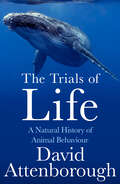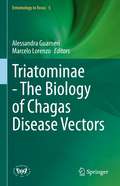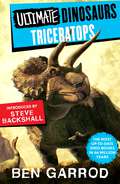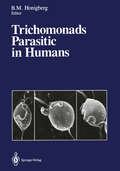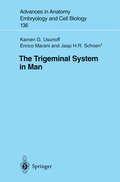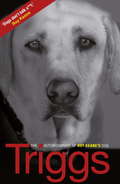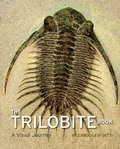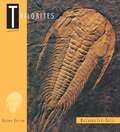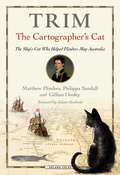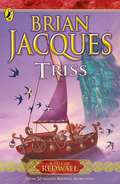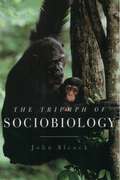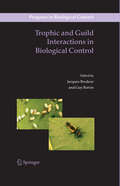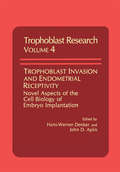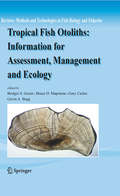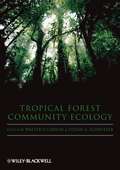- Table View
- List View
The Trials of Life: A Natural History Of Animal Behaviour
by David AttenboroughThe third and final updated edition of David Attenborough’s classic Life trilogy. Life on Earth covered evolution, Living Planet , ecology, and now The Trials of Life tackles ethology, the study of how animals behave.
Triatominae - The Biology of Chagas Disease Vectors (Entomology in Focus #5)
by Alessandra Guarneri Marcelo LorenzoThis book aims to present updated knowledge on various aspects of the natural history, biology, and impact of triatomines to all interested readers. Each chapter will be written by authorities in the respective field, covering topics such as behavior, neurophysiology, immunology, ecology, and evolution. The contents will consider scientific, as well as innovative perspectives, on the problems related to the role of triatomine bugs as parasite vectors affecting millions in the Latin American region.
Triceratops (Ultimate Dinosaurs #3)
by Ben GarrodDid Triceratops have huge, inflatable nose balloons? Was it smaller or larger than an elephant? And did it have a beak or teeth or BOTH? Quench your thirst for dino knowledge with the Ultimate Dinosaur series!Pop a dinosaur in your pocket! Introductions from Chris Packham, Steve Backshall and Dr Jane Goodall. These are the most up-to-date dino books in 66 million years, also available in audio download!TV scientist, Professor Ben Garrod, is proud to be a geek as he mixes top level science and humour to prove that science is for everyone. Looking at the evolutionary arms race, prey, predators, place, time, groups and species, Ben reveals new-look dinosaurs. Additional sections include: Ask an Expert, New Science and Fossil Finder as well as quizzes to test your dinosaur knowledge.
The Trigeminal System in Man (Advances in Anatomy, Embryology and Cell Biology #136)
by Kamen G. Usunoff Enrico Marani Jaap H.R. SchoenThis monograph offers a comprehensive review of present knowledge of the structure and connections of the trigeminal nuclei in humans, and compares it to laboratory animal findings. The authors provide cytoarchitectural data from their own research, and trace trigeminal pathways in human material by means of the Nauta technique. In humans the trigeminal nuclear complex includes the motor nucleus, the principal sensory (pontine) nucleus, the spinal nucleus (subdivided into oral, interpolar and caudal nuclei), and the mesencephalic nucleus and several small nuclei. The supratrigeminal nucleus, as described in various mammals, is not defined in the human brain. The primary afferents to all subdivisions of the trigeminal nuclear complex in humans appear to be entirely ipsilateral. Some of the 'extratrigeminal' primary afferents described in experimental animals are also present in the human brain and the nucleus ovalis receives primary and possibly secondary afferents from the trigeminal systems. A significant difference between the human trigeminal system and the subprimate species is seen in the monosynaptic cortical projection to the motor trigeminal nucleus.
Triggs: The Autobiography of Roy Keane's Dog
by TriggsThe explosive, no-holds-barred autobiography of Triggs, Roy Keane's confidant, adviser...and dog!Ten major trophies. A missed Champions League final. Player of the Year awards. Alf-Inge Haaland. Drunken nights. Contract negotiations. Patrick Vieira. Prawn sandwiches. The explosive end to Roy's relationship with Ireland and Manchester United. Triggs - TV lover, hypochondriac, noted wit, football genius and best friend to the most talked-about footballer of his generation - was witness to it all. Funny, frank and never less than 110 per cent mean-spirited, Triggs tells the truth about what it was like to be a central player in the extraordinary drama of her master's life.
The Trilobite Book: A Visual Journey
by Riccardo Levi-SettiDistant relatives of modern lobsters, horseshoe crabs, and spiders, trilobites swam the planet’s prehistoric seas for 300 million years, from the Lower Cambrian to the end of the Permian eras—and they did so very capably. Trilobite fossils have been unearthed on every continent, with more than 20,000 species identified by science. One of the most arresting animals of our pre-dinosaur world, trilobites are also favorites among the fossil collectors of today, their crystalline eyes often the catalyst for a lifetime of paleontological devotion. And there is no collector more devoted—or more venerated—than Riccardo Levi-Setti. With The Trilobite Book, a much anticipated follow-up to his classic Trilobites, Levi-Setti brings us a glorious and revealing guide to these surreal arthropods of ancient Earth. Featuring specimens from Bohemia to Newfoundland, California to the Tucson Gem and Mineral Show, and Wales to the Anti-Atlas Mountains of Morocco, Levi-Setti’s magnificent book reanimates these “butterflies of the seas” in 235 astonishing full-color photographs. All original, Levi-Setti’s images serve as the jumping-off point for tales of his global quests in search of these highly sought-after fossils; for discussions of their mineralogical origins, as revealed by their color; and for unraveling the role of the now-extinct trilobites in our planetary history. Sure to enthrall paleontologists with its scientific insights and amateur enthusiasts with its beautiful and informative images, The Trilobite Book combines the best of science, technology, aesthetics, and personal adventure. It will inspire new collectors for eras to come.
The Trilobite Book: A Visual Journey
by Riccardo Levi-SettiDistant relatives of modern lobsters, horseshoe crabs, and spiders, trilobites swam the planet’s prehistoric seas for 300 million years, from the Lower Cambrian to the end of the Permian eras—and they did so very capably. Trilobite fossils have been unearthed on every continent, with more than 20,000 species identified by science. One of the most arresting animals of our pre-dinosaur world, trilobites are also favorites among the fossil collectors of today, their crystalline eyes often the catalyst for a lifetime of paleontological devotion. And there is no collector more devoted—or more venerated—than Riccardo Levi-Setti. With The Trilobite Book, a much anticipated follow-up to his classic Trilobites, Levi-Setti brings us a glorious and revealing guide to these surreal arthropods of ancient Earth. Featuring specimens from Bohemia to Newfoundland, California to the Tucson Gem and Mineral Show, and Wales to the Anti-Atlas Mountains of Morocco, Levi-Setti’s magnificent book reanimates these “butterflies of the seas” in 235 astonishing full-color photographs. All original, Levi-Setti’s images serve as the jumping-off point for tales of his global quests in search of these highly sought-after fossils; for discussions of their mineralogical origins, as revealed by their color; and for unraveling the role of the now-extinct trilobites in our planetary history. Sure to enthrall paleontologists with its scientific insights and amateur enthusiasts with its beautiful and informative images, The Trilobite Book combines the best of science, technology, aesthetics, and personal adventure. It will inspire new collectors for eras to come.
The Trilobite Book: A Visual Journey
by Riccardo Levi-SettiDistant relatives of modern lobsters, horseshoe crabs, and spiders, trilobites swam the planet’s prehistoric seas for 300 million years, from the Lower Cambrian to the end of the Permian eras—and they did so very capably. Trilobite fossils have been unearthed on every continent, with more than 20,000 species identified by science. One of the most arresting animals of our pre-dinosaur world, trilobites are also favorites among the fossil collectors of today, their crystalline eyes often the catalyst for a lifetime of paleontological devotion. And there is no collector more devoted—or more venerated—than Riccardo Levi-Setti. With The Trilobite Book, a much anticipated follow-up to his classic Trilobites, Levi-Setti brings us a glorious and revealing guide to these surreal arthropods of ancient Earth. Featuring specimens from Bohemia to Newfoundland, California to the Tucson Gem and Mineral Show, and Wales to the Anti-Atlas Mountains of Morocco, Levi-Setti’s magnificent book reanimates these “butterflies of the seas” in 235 astonishing full-color photographs. All original, Levi-Setti’s images serve as the jumping-off point for tales of his global quests in search of these highly sought-after fossils; for discussions of their mineralogical origins, as revealed by their color; and for unraveling the role of the now-extinct trilobites in our planetary history. Sure to enthrall paleontologists with its scientific insights and amateur enthusiasts with its beautiful and informative images, The Trilobite Book combines the best of science, technology, aesthetics, and personal adventure. It will inspire new collectors for eras to come.
The Trilobite Book: A Visual Journey
by Riccardo Levi-SettiDistant relatives of modern lobsters, horseshoe crabs, and spiders, trilobites swam the planet’s prehistoric seas for 300 million years, from the Lower Cambrian to the end of the Permian eras—and they did so very capably. Trilobite fossils have been unearthed on every continent, with more than 20,000 species identified by science. One of the most arresting animals of our pre-dinosaur world, trilobites are also favorites among the fossil collectors of today, their crystalline eyes often the catalyst for a lifetime of paleontological devotion. And there is no collector more devoted—or more venerated—than Riccardo Levi-Setti. With The Trilobite Book, a much anticipated follow-up to his classic Trilobites, Levi-Setti brings us a glorious and revealing guide to these surreal arthropods of ancient Earth. Featuring specimens from Bohemia to Newfoundland, California to the Tucson Gem and Mineral Show, and Wales to the Anti-Atlas Mountains of Morocco, Levi-Setti’s magnificent book reanimates these “butterflies of the seas” in 235 astonishing full-color photographs. All original, Levi-Setti’s images serve as the jumping-off point for tales of his global quests in search of these highly sought-after fossils; for discussions of their mineralogical origins, as revealed by their color; and for unraveling the role of the now-extinct trilobites in our planetary history. Sure to enthrall paleontologists with its scientific insights and amateur enthusiasts with its beautiful and informative images, The Trilobite Book combines the best of science, technology, aesthetics, and personal adventure. It will inspire new collectors for eras to come.
Trilobites: A Visual Journey
by Riccardo Levi-SettiLong before dinosaurs roamed the earth, there were trilobites—one of the most striking animals to populate prehistoric seas and whose fossils are favorites among collectors today. From the giant trilobites of Newfoundland to fascinating new specimens from Morocco, Levi-Setti's magnificent book brings these "butterflies of the sea" to life for everyone curious about our remote past This second edition features coverage of a greater variety of trilobites, an improved photographic atlas reorganized to present their evolutionary progression, and over 200 photographs.
Trim, The Cartographer's Cat: The ship's cat who helped Flinders map Australia
by Matthew Flinders Gillian Dooley Philippa SandallNot many ships' cats have even one memorial statue, let alone six. But Trim does, including one outside Euston Station in London, proudly unveiled by Prince William on the bicentenary of Matthew Flinders's death – 19 July 2014. Trim was the ship's cat who accompanied Matthew Flinders on his voyages to circumnavigate and map the coastline of Australia from 1801 to 1803. He lived quite the adventurous life. As a small kitten he fell overboard while at sea but managed to swim back to the vessel and climb back on board by scaling a rope. This cemented his position as Flinders's beloved companion, and together they survived a Pacific voyage, the circumnavigation of Australia and a shipwreck. When Flinders was imprisoned by the French in Mauritius in 1803 Trim shared his captivity until one day he mysteriously disappeared – which heartbreakingly Flinders attributed to his being stolen and eaten by a hungry slave.Trim, The Cartographer's Cat is an ode to this much-loved ship's cat, which will warm the heart of any cat lover. The first part of the book reproduces Flinders' own whimsical tribute to Trim, written while in captivity in the early 1800s, with added 'friendly footnotes' to provide some background to Flinders's numerous literary allusions and nautical terms. Next the book discusses where Flinders was when he wrote his tribute and why, and what his letters and journals from that time tell us about his 'sporting, affectionate and useful companion'. Finally, we learn what Trim's views on all of this might have been, in a fun and fanciful observation on his premature epitaph. Accompanying all of this are beautiful maps, historical photographs, quirky original illustrations by illustrator Ad Long and excerpts from Flinders' original script, showing his beautiful handwriting. This book will make a unique and treasured gift for Flinders fans, Trim fans and cat lovers around the world.
Trim, The Cartographer's Cat: The ship's cat who helped Flinders map Australia
by Matthew Flinders Gillian Dooley Philippa SandallNot many ships' cats have even one memorial statue, let alone six. But Trim does, including one outside Euston Station in London, proudly unveiled by Prince William on the bicentenary of Matthew Flinders's death – 19 July 2014. Trim was the ship's cat who accompanied Matthew Flinders on his voyages to circumnavigate and map the coastline of Australia from 1801 to 1803. He lived quite the adventurous life. As a small kitten he fell overboard while at sea but managed to swim back to the vessel and climb back on board by scaling a rope. This cemented his position as Flinders's beloved companion, and together they survived a Pacific voyage, the circumnavigation of Australia and a shipwreck. When Flinders was imprisoned by the French in Mauritius in 1803 Trim shared his captivity until one day he mysteriously disappeared – which heartbreakingly Flinders attributed to his being stolen and eaten by a hungry slave.Trim, The Cartographer's Cat is an ode to this much-loved ship's cat, which will warm the heart of any cat lover. The first part of the book reproduces Flinders' own whimsical tribute to Trim, written while in captivity in the early 1800s, with added 'friendly footnotes' to provide some background to Flinders's numerous literary allusions and nautical terms. Next the book discusses where Flinders was when he wrote his tribute and why, and what his letters and journals from that time tell us about his 'sporting, affectionate and useful companion'. Finally, we learn what Trim's views on all of this might have been, in a fun and fanciful observation on his premature epitaph. Accompanying all of this are beautiful maps, historical photographs, quirky original illustrations by illustrator Ad Long and excerpts from Flinders' original script, showing his beautiful handwriting. This book will make a unique and treasured gift for Flinders fans, Trim fans and cat lovers around the world.
Triss (Redwall)
by Brian JacquesThe fifteenth book in the beloved, bestselling Redwall saga - soon to be a major Netflix movie!Triss is a brave squirrelmaid - enslaved by the evil ferret King Agarnu of Riftgard and his cruel daughter, Kurna. But, secretly, Triss is planning a daring escape by sea . . .As Triss sets sail, three young friends leave Salamandastron in search of adventure - and two youngsters go missing in Mossflower Woods. After three dangerous journeys, the travellers' paths cross at the famous Redwall Abbey - where Triss will discover her destiny, and a new champion will rise to carry the legendary sword of Martin the Warrior and fight for the future of Redwall . . .
The Triumph of Henry Cecil: The Authorised Biography
by Tony Rushmer'A wonderfully insightful, detailed and emotional biography of the legendary trainer's later years' Racing Post'[Cecil's] is a remarkable story and it has now been told with compassion, love, honesty and wonderful insight by Tony Rushmer' David Walsh, Sunday TimesWith a foreword by John GosdenWhen Henry Cecil sent out just 12 winners in 2005 it seemed as if the 10-time champion racehorse trainer's career was in terminal decline. The masterly touch that he'd shown through the glory-days of the two previous decades appeared to have deserted him after a series of painful professional and personal blows, including the death of his twin brother David. When Cecil was diagnosed with cancer in June 2006, it would have been enough to break many a man. But behind the scenes, the master of Warren Place in Newmarket was determined not to be labelled - in his words - a 'has-been'. Showing an iron resolve to fight for his professional reputation as well as his life, Cecil staged one of the great sporting comebacks. It was a story that captured the imagination of the racing public and beyond, peaking with his supreme handling of the unbeaten champion Frankel. Cecil's astonishing revival was witnessed in close-up by Tony Rushmer. The sports journalist became a trusted stable insider after being engaged in spring 2006 to help with the trainer's website and PR. He would remain part of the team right up until Cecil died in June 2013. Rushmer's unique access over seven years - in which he saw Cecil at the best and worst of times - allows him to provide a fresh perspective on an incredible part of the trainer's career. He is helped by many of those who were closest to the story, having interviewed numerous people during his extensive research. Containing fascinating detail and a wealth of new material, The Triumph of Henry Cecil shows how Cecil emerged from his slump, displayed relentless strength in the face of a cruel disease and trained the magnificent Frankel - as brilliant a racehorse as the sport has ever known.
The Triumph of Sociobiology
by John AlcockIn The Triumph of Sociobiology, John Alcock reviews the controversy that has surrounded evolutionary studies of human social behavior following the 1975 publication of E.O. Wilson's classic, Sociobiology, The New Synthesis. Denounced vehemently as an "ideology" that has justified social evils and inequalities, sociobiology has survived the assault. Twenty-five years after the field was named by Wilson, the approach he championed has successfully demonstrated its value in the study of animal behavior, including the behavior of our own species. Yet, misconceptions remain--to our disadvantage. In this straight-forward, objective approach to the sociobiology debate, noted animal behaviorist John Alcock illuminates how sociobiologists study behavior in all species. He confronts the chief scientific and ideological objections head on, with a compelling analysis of case histories that involve such topics as sexual jealousy, beauty, gender difference, parent-offspring relations, and rape. In so doing, he shows that sociobiology provides the most satisfactory scientific analysis of social behavior available today. Alcock challenges the notion that sociobiology depends on genetic determinism while showing the shortcoming of competing approaches that rely on cultural or environmental determinism. He also presents the practical applications of sociobiology and the progress sociobiological research has made in the search for a more complete understanding of human activities. His reminder that "natural" behavior is not "moral" behavior should quiet opponents fearing misapplication of evolutionary theory to our species. The key misconceptions about this evolutionary field are dissected one by one as the author shows why sociobiologists have had so much success in explaining the puzzling and fascinating social behavior of nonhuman animals and humans alike.
Trophic and Guild Interactions in Biological Control (Progress in Biological Control #3)
by Jacques Brodeur Guy BoivinThis volume explores modern concepts of trophic and guild interactions among natural enemies in natural and agricultural ecosystems - a field that has become a hot topic in ecology and biological control over the past decade. It is the first book on trophic and guild interactions to make the link to biological control, and is compiled by internationally recognized scientists who have combined their expertise.
Trophoblast Invasion and Endometrial Receptivity: Novel Aspects of the Cell Biology of Embryo Implantation (Trophoblast Research #4)
by John D. Aplin Hans-Werner DenkerInterest in mechanisms of embryo implantation is increasing, particularly with the realization that failure of implantation after in vitro fertilization and embryo transfer places significant limits on the success of treatment. In addition, there is a need to provide hypotheses, and ultimately mechanisms, for the high rates of embryonic loss in women in the population at large. Traditionally, implantation research has concentrated on genetics and endocrinology without providing many therapeutic benefits. A new era is now beginning with the application of modem cellular and molecular approaches to the investigation of the relationship between trophoblast and endometrium. At the same time, older data can be reevaluated in the light of current research into cell cell and cell-matrix interactions. The feeling that new avenues of research are open was apparent when an international group of scientists came together at a workshop on "The Cell Biology of Trophoblast Invasion In Vivo and In Vitro" held during the XXIV Annual Meeting of the Cell, Tissue and Organ Culture Study Group (C.T.O.C.) at Heidelberg in 1986. What was unusual about this Conference was the interdisciplinary dialogue between implantation researchers and tumor biologists, highlighting aspects common to invasion of trophoblast and tumor cells.
Trophy Hunting
by Nikolaj Bichel Adam HartThis book gets to the heart of trophy hunting, unpacking and explaining its multiple facets and controversies, and exploring why it divides environmentalists, the hunting community, and the public. Bichel and Hart provide the first interdisciplinary and comprehensive approach to the study of trophy hunting, investigating the history of trophy hunting, and delving into the background, identity and motivation of trophy hunters. They also explore the role of social media and anthropomorphism in shaping trophy hunting discourse, as well as the viability of trophy hunting as a wildlife management tool, the ideals of fair chase and sportsmanship, and what hunting trophies are, both literally and in terms of their symbolic value to hunters and non-hunters. The analyses and discussions are underpinned by a consideration of the complex moral and practical conflicts between animal rights and conservation paradigms. This book appeals to scholars in environmental philosophy, conservation and environmental studies, as well as hunters, hunting opponents, wildlife management practitioners, and policymakers, and anyone with a broad interest in human–wildlife relations.
Tropical Fish (large print)
by RnibThis image shows two fish seen from the side with their heads on the right of the page and their tails on the left of the page. There is a locator dot shown, which will be at the top left of the page when the image is the correct way up. The fish at the top of the page is a common clown-fish. On the right of the image its mouth is slightly open. Up and left one of its two eyes is shown. To the left of the fish's head is a vertical curved band of white edged with black. Left of this is one of the two rounded pectoral fins. It is coloured yellow-orange like most of the fish and has a black border edge to the top and left. The middle of the fish has another vertical forward pointing band of white edged with black. In the bottom centre of the fish is one of the two pelvic fins. In the bottom left of the fish is the single, central anal fin. These fins are also coloured yellow-orange and have a black border edge to the bottom and left. On the left of the image is the rounded tail or caudal fin. It is coloured a darker yellow-orange and has a black border edge to the left. To the right of the tail is another vertical band of white edged with black. Up and right from this is one part of the dorsal fin. It is coloured a darker yellow-orange and has a black border edge to the top and left. In the top centre of the fish is the first part of the dorsal fin. It is a darker orange colour and gets darker towards the edge. There is no distinct black border. The fish at the bottom of the page is an angelfish. In the centre of its head on the right one of its two eyes is shown. It has a larger eye orbit which is coloured bright orange. The fish is white with black vertical stripes. One of these black stripes goes across the orbit in line with the black eye iris. Down and left from the eye is an irregularly shaped gill cover. Left from the gill cover is one of the two pectoral fins with a scalloped edge. A black vertical stripe goes behind this fin. Down from this is one of the two pelvic fins, it is long, thin and curves down and left to a point. It is coloured white. To the left of the pectoral fin is another black vertical stripe. It continues onto the large pointed anal fin in the bottom left of the image as a dark grey stripe. It continues onto the large triangular dorsal fin at the top of the fish, again as a dark grey colour. The black band behind the pectoral fin also continues onto the dorsal fin briefly. There is a small black vertical stripe on the left where the tail joins the body. The tail or caudal fin is broad and white. It has a spike going left from the bottom edge.
Tropical Fish Otoliths: Information for Assessment, Management and Ecology (Reviews: Methods and Technologies in Fish Biology and Fisheries #11)
by Bridget S. Green Gavin A. Begg Gary Carlos Bruce D. MapstoneTechniques and theory for processing otoliths from tropical marine fish have developed only recently due to an historic misconception that these organisms could not be aged. Otoliths are the most commonly used structures from which daily, seasonal or annual records of a fish’s environmental history are inferred, and are also used as indicators of migration patterns, home range, spatial distribution, stock structure and life history events. A large proportion of projects undertaken on tropical marine organisms involve removal and processing of calcified structures such as otoliths, statoliths or vertebrae to retrieve biological, biochemical or genetic information. Current techniques and principles have evolved rapidly and are under constant modification and these differ among laboratories, and more particularly among species and within life history stages. Tropical fish otoliths: Information for assessment, management and ecology is a comprehensive description of the current status of knowledge about otoliths in the tropics. This book has contributions from leading experts in the field, encompassing a tropical perspective on daily and annual ageing in fish and invertebrates, microchemistry, interpreting otolith microstructure and using it to back-calculate life history events, and includes a treatise on the significance of validating periodicity in otoliths.
Tropical Fish (UEB contracted)
by RnibThis image shows two fish seen from the side with their heads on the right of the page and their tails on the left of the page. There is a locator dot shown, which will be at the top left of the page when the image is the correct way up. The fish at the top of the page is a common clown-fish. On the right of the image its mouth is slightly open. Up and left one of its two eyes is shown. To the left of the fish's head is a vertical curved band of white edged with black. Left of this is one of the two rounded pectoral fins. It is coloured yellow-orange like most of the fish and has a black border edge to the top and left. The middle of the fish has another vertical forward pointing band of white edged with black. In the bottom centre of the fish is one of the two pelvic fins. In the bottom left of the fish is the single, central anal fin. These fins are also coloured yellow-orange and have a black border edge to the bottom and left. On the left of the image is the rounded tail or caudal fin. It is coloured a darker yellow-orange and has a black border edge to the left. To the right of the tail is another vertical band of white edged with black. Up and right from this is one part of the dorsal fin. It is coloured a darker yellow-orange and has a black border edge to the top and left. In the top centre of the fish is the first part of the dorsal fin. It is a darker orange colour and gets darker towards the edge. There is no distinct black border. The fish at the bottom of the page is an angelfish. In the centre of its head on the right one of its two eyes is shown. It has a larger eye orbit which is coloured bright orange. The fish is white with black vertical stripes. One of these black stripes goes across the orbit in line with the black eye iris. Down and left from the eye is an irregularly shaped gill cover. Left from the gill cover is one of the two pectoral fins with a scalloped edge. A black vertical stripe goes behind this fin. Down from this is one of the two pelvic fins, it is long, thin and curves down and left to a point. It is coloured white. To the left of the pectoral fin is another black vertical stripe. It continues onto the large pointed anal fin in the bottom left of the image as a dark grey stripe. It continues onto the large triangular dorsal fin at the top of the fish, again as a dark grey colour. The black band behind the pectoral fin also continues onto the dorsal fin briefly. There is a small black vertical stripe on the left where the tail joins the body. The tail or caudal fin is broad and white. It has a spike going left from the bottom edge.
Tropical Fish (UEB uncontracted)
by RnibThis image shows two fish seen from the side with their heads on the right of the page and their tails on the left of the page. There is a locator dot shown, which will be at the top left of the page when the image is the correct way up. The fish at the top of the page is a common clown-fish. On the right of the image its mouth is slightly open. Up and left one of its two eyes is shown. To the left of the fish's head is a vertical curved band of white edged with black. Left of this is one of the two rounded pectoral fins. It is coloured yellow-orange like most of the fish and has a black border edge to the top and left. The middle of the fish has another vertical forward pointing band of white edged with black. In the bottom centre of the fish is one of the two pelvic fins. In the bottom left of the fish is the single, central anal fin. These fins are also coloured yellow-orange and have a black border edge to the bottom and left. On the left of the image is the rounded tail or caudal fin. It is coloured a darker yellow-orange and has a black border edge to the left. To the right of the tail is another vertical band of white edged with black. Up and right from this is one part of the dorsal fin. It is coloured a darker yellow-orange and has a black border edge to the top and left. In the top centre of the fish is the first part of the dorsal fin. It is a darker orange colour and gets darker towards the edge. There is no distinct black border. The fish at the bottom of the page is an angelfish. In the centre of its head on the right one of its two eyes is shown. It has a larger eye orbit which is coloured bright orange. The fish is white with black vertical stripes. One of these black stripes goes across the orbit in line with the black eye iris. Down and left from the eye is an irregularly shaped gill cover. Left from the gill cover is one of the two pectoral fins with a scalloped edge. A black vertical stripe goes behind this fin. Down from this is one of the two pelvic fins, it is long, thin and curves down and left to a point. It is coloured white. To the left of the pectoral fin is another black vertical stripe. It continues onto the large pointed anal fin in the bottom left of the image as a dark grey stripe. It continues onto the large triangular dorsal fin at the top of the fish, again as a dark grey colour. The black band behind the pectoral fin also continues onto the dorsal fin briefly. There is a small black vertical stripe on the left where the tail joins the body. The tail or caudal fin is broad and white. It has a spike going left from the bottom edge.
Tropical Forest Community Ecology
by Walter P. Carson Stefan A. SchnitzerHistorically, tropical ecology has been a science often content with descriptive and demographic approaches, which is understandable given the difficulty of studying these ecosystems and the need for basic demographic information. Nonetheless, over the last several years, tropical ecologists have begun to test more sophisticated ecological theory and are now beginning to address a broad array of questions that are of particular importance to tropical systems, and ecology in general. Why are there are so many species in tropical forests and what mechanisms are responsible for the maintenance of that vast species diversity? What factors control species coexistence? Are there common patterns of species abundance and distribution across broad geographic scales? What is the role of trophic interactions in these complex ecosystems? How can these fragile ecosystems be conserved? Containing contributions from some of the world’s leading tropical ecologists, Tropical Forest Community Ecology provides a summary of the key issues in the discipline of tropical ecology: Includes contributions from some of the world’s leading tropical ecologists Covers patterns of species distribution, the maintenance of species diversity, the community ecology of tropical animals, forest regeneration and conservation of tropical ecosystems
Tropical Forest Community Ecology
by Walter Carson Stefan SchnitzerHistorically, tropical ecology has been a science often content with descriptive and demographic approaches, which is understandable given the difficulty of studying these ecosystems and the need for basic demographic information. Nonetheless, over the last several years, tropical ecologists have begun to test more sophisticated ecological theory and are now beginning to address a broad array of questions that are of particular importance to tropical systems, and ecology in general. Why are there are so many species in tropical forests and what mechanisms are responsible for the maintenance of that vast species diversity? What factors control species coexistence? Are there common patterns of species abundance and distribution across broad geographic scales? What is the role of trophic interactions in these complex ecosystems? How can these fragile ecosystems be conserved? Containing contributions from some of the world’s leading tropical ecologists, Tropical Forest Community Ecology provides a summary of the key issues in the discipline of tropical ecology: Includes contributions from some of the world’s leading tropical ecologists Covers patterns of species distribution, the maintenance of species diversity, the community ecology of tropical animals, forest regeneration and conservation of tropical ecosystems
